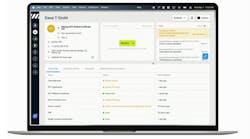Vehicles to make a connection in the future
The first 50 years of vehicle safety has been focused on surviving crashes, while the next 50 will be about avoiding crashes, said Peter Appel, administrator of the U.S. Dept. of Transportation’s Research and Innovative Technology Administration (RITA).
Technology will be key to achieving unprecedented levels of safety, Appel said, especially in the area of “connected” vehicles, which communicate wirelessly with each other, as well as with traffic signals, toll booths and other infrastructure.
Vehicle-to-vehicle (V2V) communications systems provide awareness of other, similarly equipped vehicles within range. This can include cars, buses, trucks and public transit vehicles. A recent report from the National Highway Traffic Safety Administration (NHTSA) found that V2V and vehicle to infrastructure (V2I) technology has the potential to address 81% of all vehicle target crashes, Appel stated. “One reason is that non-distracting safety alerts focus a driver’s attention on potential roadway dangers such as cars that brake suddenly, speed limit changes or an approaching emergency vehicle. These alerts will help to create more aware and responsible drivers.”
Under a cooperative agreement with a consortium of vehicle manufacturers, DOT has developed several V2V and V2I safety technologies that include:
•Blind spot warnings — which warn a driver if there is a car in the blind spot when they try to change lanes.
• Forward collision warnings — which alert and then warn a driver of the need to brake when a vehicle ahead of them is stopped, applying their brakes, or traveling more slowly.
•Electronic emergency brake lights — which notify drivers when a vehicle ahead is braking hard.
• Intersection movement assist — which warns the driver when it is not safe to enter an intersection, for example, when something is blocking a driver’s view of opposing traffic.
•Do not pass warnings — which warn drivers if they attempt to change lanes and pass when there is a vehicle in the opposing lane within the passing zone.
• Control loss warnings — which warn drivers when they are about to lose control of the vehicle.
These alerts can be communicated to the driver in a number of ways, Appel explained. RITA is conducting research into the human factors associated with wireless connectivity between vehicles and onboard safety devices.
“We want to ensure that these technologies do not contribute to any distracted driving problems,” he said.
“In addition, V2V and V2I communications over a secure network will generate hundreds of new data sets, which can be used to create a myriad of safety, mobility and environmental applications,” he added. “Imagine traffic lights that can make real-time decisions that keep traffic flowing or prevent oncoming crashes from happening. What if a specially equipped cell phone could help a blind pedestrian cross a busy intersection safely? We realize the potential of these applications, which is why our department is insisting that this system be based on open-source standards to ensure unlimited potential for commercial innovation.”


